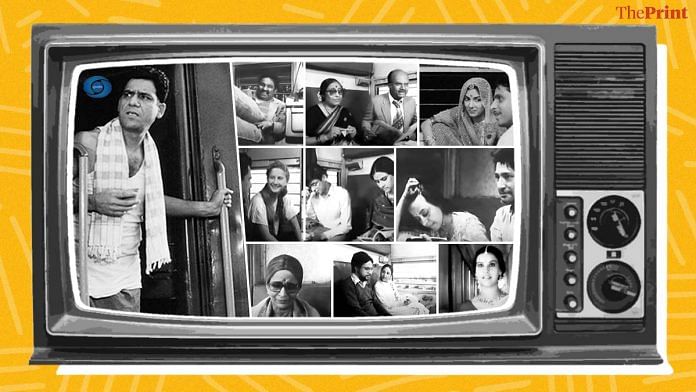Long before Aditya Chopra even began writing the script for Dilwale Dulhania Le Jayenge (1995), which heroed the Indian Railways with its iconic train scene, Shyam Benegal’s 1986 Doordarshan serial, Yatra, had already epitomised the tele-representation of travel in India when everyone took the train.
Featuring a talent-loaded star cast including Om Puri, Neena Gupta, Ila Arun, Mohan Gokhale and Harish Patel among others, Yatra was more than just picture-perfect postcards from diverse parts of India. It gave importance to relationships — between lovers, parents and children, siblings, mentors and even strangers, their victories and failures. With a robbery, a recovery, a fatal accident, a suicide attempt, sexual harassment and more, the series encapsulated all that life has to offer, good or bad.
An army man headed back to Jammu after his vacation in Trivandrum with a disgruntled wife, parents who have just cremated their daughter where the Arabian Sea and the Bay of Bengal meet, a theatre actor in pursuit of reaching his troupe in Delhi on time and an ailing sadhu with his protege who is determined to reach the Himalayas — all are brought together on the first episode of the show, written by Shama Zaidi and Sunil Shanbag. The travellers meet on the Himsagar Express — the longest-running train at that time, from Kanyakumari to Jammu Tawi.
As the series progresses, little slices of the lives of the travellers emerge, enveloping the viewer, and each other, in their stories. Om Puri’s character (the jawan) succinctly summarises the show in just one line, “On a train, your destination is all important. In life, it is all about the journey.”
Also read: Chandrakanta, the show in which Irrfan won hearts four lines at a time
Shyam Benegal’s genius and the generosity of the Indian Railways
Funded by the Indian Railways, which also provided Benegal with a 10-bogey train for 50 days at the cost of Rs 30 lakhs, the show was predictably involved in controversy. The Minister of State for Railways at that time, Madhav Rao Scindia, was questioned for clearing the project “without seeking the prior consent of the financial commissioner in the Railway Board.”
Also, the fact that it was sponsored for Doordarshan by Bombay Dyeing, a company in which Scindia had a shareholding interest and whose then chairman, Nusli Wadia, he was friends with, added to the controversy.
But Benegal simply thought of it as “a great adventure. The railway department was very cooperative. They used to make way for our train at many stops.”
“I chose the two longest journeys one could take by train for the show. It was an extraordinary experience, as I had several talented actors and technicians working on the series. We had a train at our disposal. The show introduced different parts of India not only to the audience, but also to us,” he said.
Also read: Bharat Ek Khoj: Shyam Benegal’s adaption of Nehru’s Discovery of India was a Sunday staple
The diversity it showcased makes it much needed today
National-award winning cinematographer Jehangir Chowdhury’s vision was so ahead of his time that the series makes for an engaging and gripping experience even today. The different parts of India that Benegal talked about were brought to life on screen with meticulous attention to detail that only someone of Chowdhury’s stature could deliver, showcasing India in all its diverse glory.
Every episode opens with a voiceover, narrating the history of the railways and some statistics from 1986. Since its inception, rail have been a crucial part of daily life — and till today continue to be a medium of reasonably affordable travel — at one point, the only choice of travel. Benegal exploits this fact in the diversity of stories he brings.
In the rush and bustly of life as we know it, people focus on getting to their destination as quickly as possible, and don’t really think of the journey except as a commute. But in Benegal’s frames and with his talent for storytelling, that is impossible, and that’s what people remember.
“I relate my childhood with railways. Air journeys just do not have that charm. I miss those train journeys, it has been so long,” recalls Nishi Kumar, a resident of Delhi.
For those who have travelled via trains, the series provided familiarity along with insights. But for those who hadn’t, it opened their eyes to an entirely different world. In Chowdhury’s cinematography, Agra’s Taj Mahal or the camels in Jaipur with the sunset backdrop and endless sand dunes were almost as good as the real deal.
“The show had excellent production values even at that time! The cinematography was perfect, tracing the guy from the door through the narrow corridors in a single smooth shot” Shreejith S. tells ThePrint.
“I started watching television for the first time with these serials. Oh such a lovely time it was, opening up to a new world,” said Allahabad’s Arijit Upadhyay, who spent seven years in hostel till class 10th without any television.
But it has been decades since the underappreciated gem was aired on Doordarshan and not too many remember it now. What is worth remembering, however, is the mirror that Benegal and co. held up to the nation’s diversity.
“I don’t think anyone will be able to make a show like this today,” Benegal once said, and there shall be no other for it would be sacrilege.
Also read: Yeh Jo Hai Zindagi, the middle-class comedy that gave Doordarshan loyal fans for life







Hi, thanks for this write up. Is this series available in full on any online platform? YouTube has the first 12 episodes, the last 3 are missing.
Any information would be usefull! Thanks in advance.